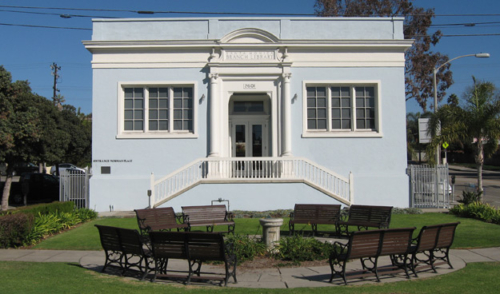Ocean Park Library

- Known As
- Neoclassical
- Architect
- Kegley & Garity
- Built
- 1917
- Designated
- May 3, 1977
The Ocean Park Library is a Neoclassical structure completed in 1918. Situated on the corner of Main Street and Ocean Park Boulevard, it has long been a focal point of community life in Ocean Park.
The Ocean Park Library was built with funding from steel baron and philanthropist Andrew Carnegie. Carnegie believed that public libraries were the key to self-improvement for ordinary Americans. Thus, in the years between 1886 and 1917, Carnegie financed the construction of 2,811 public libraries, most of which were in the United States.
As a rule, Carnegie provided money only for the construction of library buildings. Towns that received libraries were required to provide the land, books, and long-term maintenance. As such, this library required a commitment to civic improvement on the part of Santa Monicans at the time. The city was growing fast in the 1910s and, eager to improve the city’s amenities, residents readily accepted these responsibilities. The Tegner family did more than their share in donating the land, which had formerly been the site of their home.
Santa Monica was actually granted two Carnegie libraries. The first, built in 1904, was located at Fifth and Oregon Avenue (now Santa Monica Boulevard) and has since been replaced by more modern library buildings. Many other Carnegie libraries have met a similar fate, making the Ocean Park library one of the few surviving Carnegie libraries in the region.
Carnegie libraries were built in a wide variety of architectural styles but classically-inspired structures were most typical. This reflected a surge in interest in the architecture of ancient Greece and Rome that had begun in the 1890s and continued through the early part of the twentieth century. Neoclassical architecture was particularly appropriate for public libraries because it expressed a link to civic and democratic values of the past.
Although the library was enlarged by a modern addition (completed in 1985), and patrons now enter the building from the side, the original structure retains its Neoclassical integrity. In keeping with the style, the original building is symmetrical, with the doorway placed at the center of the Main Street façade and casement windows on either side of the entranceway. Most of the ornamental elements surround the doorway, including a set of engaged columns topped by an arched pediment. The roofline is enhanced by a molded cornice capped by a parapet. Overall, architects Kegley and Garity opted for a simplified version of the Neoclassical style well-suited to this modestly-scaled structure. Working together with Carnegie’s support and the community’s commitment, they created an attractive public space that remains as useful today as ever.
Sources:
- Kenneth A. Breisch. Henry Hobson Richardson and the Small Public Library in America: A Study in Typology. Cambridge MA: MIT Press, 1997.
- Jonathan Glancey. The Story of Architecture. New York: Dorling Kindersley, 2000.
- Cyril M. Harris. American Architecture: An Illustrated Encyclopedia. New York: W.W. Norton, 1998.
- Timothy Rub. “‘The Day of Big Operations:’ Andrew Carnegie and his Libraries.” Architectural Record, July 1985.
- Santa Monica Historic Resources Inventory, 1985-1986. City of Santa Monica, Building and Safety Department.
- Staff Report on 2601 Main Street, Ocean Park Library. City Planning Division, Santa Monica.